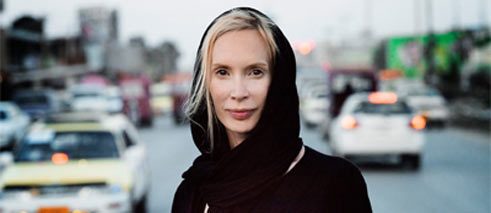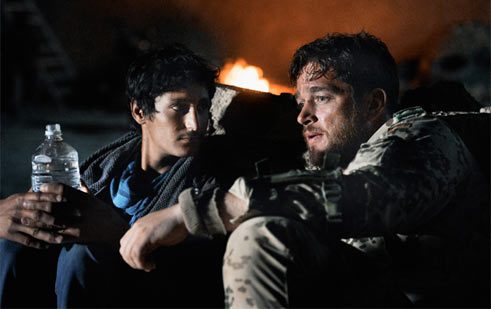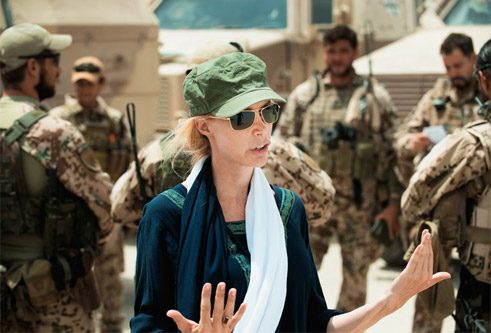Feo Aladag
Stories in the “Inbetween Worlds”

Two films in particular have helped Feo Aladag to make a name for herself as a courageous film director in Germany. Her empathetic way of looking at cultural conflicts characterizes her work.
Feo Aladag has a weakness for high-risk movie material and she is most definitely not afraid of tackling explosive issues. This was already very much the case in her acclaimed debut as a director in 2010 with Die Fremde (When We Leave) – a film about the events leading up to an honour killing. Her second film, Zwischen Welten (Inbetween Worlds), which was entered at the Berlinale Film Festival, was shot on location in Afghanistan. This film is a war drama about a soldier of the German Armed Forces who tries to protect a local interpreter and his sister and it shows just how abreast of the times she is. It was in fact not until quite recently that attention of politics and media has started to be paid to the fate of the local Afghan, non-military personnel, who will quite possibly be at the mercy of the vengeful Taliban when the ISAF troops withdraw from the country, as is planned.
German Film Prize for “Die Fremde”
 Settar Tanriögen and Sibel Kekilli as father and daughter in “Die Fremde”. | Majestic
| © Bothar / Majestic
How did this blond, translucently delicate-looking woman manage to make a name for herself as one of the most daring voices in the realm of German-language cinema with just two films? It was a slow, but continual, process in which Feo Aladag, born in Vienna in 1972, felt her way to the director’s chair. While she was studying psychology and communication science at university, which she concluded with a PhD, she also took a course, at the same time, in acting. She then went on to gather experience in the trade by writing film reviews, screenplays for TV-crime dramas, by acting in TV roles and by directing advertising films.
Settar Tanriögen and Sibel Kekilli as father and daughter in “Die Fremde”. | Majestic
| © Bothar / Majestic
How did this blond, translucently delicate-looking woman manage to make a name for herself as one of the most daring voices in the realm of German-language cinema with just two films? It was a slow, but continual, process in which Feo Aladag, born in Vienna in 1972, felt her way to the director’s chair. While she was studying psychology and communication science at university, which she concluded with a PhD, she also took a course, at the same time, in acting. She then went on to gather experience in the trade by writing film reviews, screenplays for TV-crime dramas, by acting in TV roles and by directing advertising films.In 2005, in order to make her first feature film, Die Fremde, she founded a production company in collaboration with her then husband, Züli Aladag. She invested all the money she had in the production and thought she would have to take on a few more acting roles to recoup her losses. Her fears turned out to be unfounded thanks to the worldwide success of her debut, for which she received 47 awards, one of which was the German Film Prize.
Her film, Zwischen Welten (Inbetween Worlds), was the first film to be shot right in the middle of a military zone and it also demanded a great deal from her. During shooting the single-mum-cum-director lived on the Masar-i-Sharif military base in Afghanistan with her little daughter. Although she was under the protection of the German Armed Forces and the Afghan police, she still ran into a few dicey situations.
Authentic depiction of cultural conflicts
 Friendship between a local interpreter and a soldier of the German Armed Forces: Mohsin Ahmadi and Ronald Zehrfeld in “Zwischen Welten”.
| © Björn Kommerell / Majestic
Authenticity is important to her. “If you really want to portray people who are doing this job in this country, then it is part of your own, personal obligation to care and thoroughness to do it as authentically as possible” – she could of course have shot the film in Morocco, for example, as is usually the case. She also used this same attention to care and thoroughness for the filming of Die Fremde (When We Leave). It tells the story of Umay, a German-born Turkish woman, who takes her young son and runs away from her violent husband in Istanbul to go back to her beloved family in Berlin. Umay strives to find her personal freedom, but in the process is branded a “German whore”“, bringing shame on her family. In order to depict Umay’s fate realistically, Aladag lived for while in a women’s shelter and attended a few court cases. In her portrayal of intercultural conflicts she also manages to empathise with the perpetrators’ perspective and shows how they, too, suffer from the pressure of traditional norms. For her second film she insisted on having Afghan amateur actors, who know from their own experience what it is like when the soldiers of a foreign army march into a village.
Friendship between a local interpreter and a soldier of the German Armed Forces: Mohsin Ahmadi and Ronald Zehrfeld in “Zwischen Welten”.
| © Björn Kommerell / Majestic
Authenticity is important to her. “If you really want to portray people who are doing this job in this country, then it is part of your own, personal obligation to care and thoroughness to do it as authentically as possible” – she could of course have shot the film in Morocco, for example, as is usually the case. She also used this same attention to care and thoroughness for the filming of Die Fremde (When We Leave). It tells the story of Umay, a German-born Turkish woman, who takes her young son and runs away from her violent husband in Istanbul to go back to her beloved family in Berlin. Umay strives to find her personal freedom, but in the process is branded a “German whore”“, bringing shame on her family. In order to depict Umay’s fate realistically, Aladag lived for while in a women’s shelter and attended a few court cases. In her portrayal of intercultural conflicts she also manages to empathise with the perpetrators’ perspective and shows how they, too, suffer from the pressure of traditional norms. For her second film she insisted on having Afghan amateur actors, who know from their own experience what it is like when the soldiers of a foreign army march into a village.
Patriarchal structures in a different light
Interview with Feo Aladag about “Die Fremde”From a socio-political point of view the films of Feo Aladag have led her into a minefield. Audiences, however, were moved by her multifaceted treatment of the taboo subject of “honour killing” – a subject the general public usually only finds out about from outraged headlines in newspapers. “It is high time we started talking about the conflicts that arise along the road from the Bosphorus to Berlin,” said Claudius Seidl, film critic at the Frankfurter Allgemeine Zeitung newspaper. We really ought to be seeing more films like this, hearing more of these stories.”
When confronted with accusations of using clichés about the Turks, the director said, “I am interested in the psychological mechanisms that lead to such behaviour.” For “If I am to take the person I am dealing with really seriously, then I have to be able to put my cards on the table and talk about things that are not in order.” The way she views patriarchal structures is both detached, yet at the same time empathetic. This is to be felt in Zwischen Welten (Inbetween Worlds), and is reminiscent of the American director, Kathryn Bigelow, who also delves into the domains of men.
Believing in reaching out to people
 Director Feo Aladag working at “Zwischen Welten”.
| © Wolfgang Ennenbach / Majestic
As a director who focuses on controversial topics Feo Aladag, like Bigelow, gives the impression of an outsider. Over the last few years German film productions have split more and more into either coarse, yet crowd-pulling “feel good” comedies or artistically sophisticated “art house” films that only get through to a small audience and are often maligned as overly intellectual and somewhat garbled. Feo Aladag, however, is somewhat of a pioneer, because she addresses painful subjects and, at the same time, offsets social commitment and feeling with a formal stringency. What makes her films so outstanding is their subtle plea for love, faith and hope. “Faith,” says Aladag, “not so much in the explicitly religious sense of the word, but more faith in people reaching out to each other. The faith or the belief that harmonious coexistence would be possible, if we, in the name of empathy, were able to break away from our principles and convictions.”
Director Feo Aladag working at “Zwischen Welten”.
| © Wolfgang Ennenbach / Majestic
As a director who focuses on controversial topics Feo Aladag, like Bigelow, gives the impression of an outsider. Over the last few years German film productions have split more and more into either coarse, yet crowd-pulling “feel good” comedies or artistically sophisticated “art house” films that only get through to a small audience and are often maligned as overly intellectual and somewhat garbled. Feo Aladag, however, is somewhat of a pioneer, because she addresses painful subjects and, at the same time, offsets social commitment and feeling with a formal stringency. What makes her films so outstanding is their subtle plea for love, faith and hope. “Faith,” says Aladag, “not so much in the explicitly religious sense of the word, but more faith in people reaching out to each other. The faith or the belief that harmonious coexistence would be possible, if we, in the name of empathy, were able to break away from our principles and convictions.”